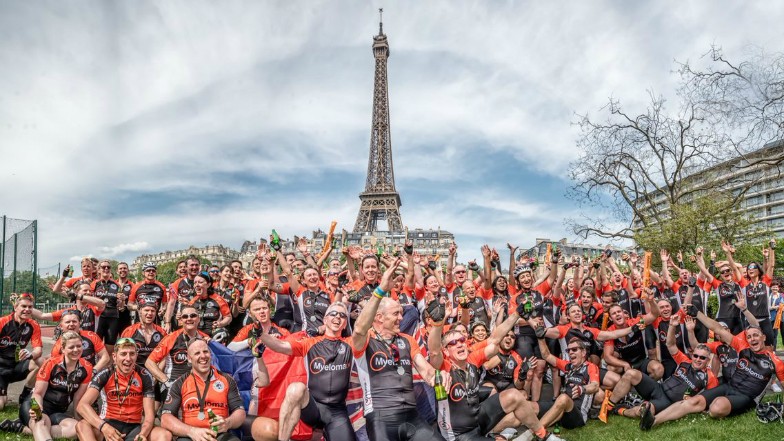Life with multiple myeloma

Multiple myeloma patient Bob Munro (pictured below) explains what it's like to live with the rare blood cancer and how his diagnosis led him on the journey of a lifetime – cycling from London to the Arc de Triomphe.
To describe yourself as lucky when you’ve been diagnosed as having a rare incurable bone marrow cancer could easily qualify you for a visit from the men in white coats, but then what’s another couple of white coats when you’ve been surrounded by them for more than seven years?
It certainly wasn’t my first reaction when the consultant treating me for pneumonia told me I had a tumour. “You mean cancer?” I interrupted, sensing that this wasn’t a word he wanted to use. “Yes, it’s in your bone marrow and it’s called myeloma”, which it turns out 97% of people, including me, have never heard of. I’ve had better news.
 As I dabbed away tears, I managed to take on board ‘rare, incurable, treatable, new drugs, great strides’ but the fact that it was in my bones strongly suggested to me that I was in big trouble. Surely once a cancer has migrated to your bones, you were finished? And his coup de grace “oh, and I strongly advise you not to Google it”, meaning you didn’t need to be Sherlock Holmes to know it wasn’t good.
As I dabbed away tears, I managed to take on board ‘rare, incurable, treatable, new drugs, great strides’ but the fact that it was in my bones strongly suggested to me that I was in big trouble. Surely once a cancer has migrated to your bones, you were finished? And his coup de grace “oh, and I strongly advise you not to Google it”, meaning you didn’t need to be Sherlock Holmes to know it wasn’t good.
It was no wonder he gave me that earnest but useless piece of advice; 25% of newly diagnosed patients die within the first year and only 46% live for five years. But, and here’s where I start to get lucky, my cup is resolutely half full. Some would say I’m foolishly optimistic.
Google also told me the average age at diagnosis is 69, and less than 35% of patients are under 65. I was 52 and still playing five-a-side football; surely youth and fitness must improve my chances of being in the 46%? It does, so does not having an aggressive strain.
What is multiple myeloma?
Myeloma crowds out the production of red and white blood cells in the bone marrow, leaving sufferers anaemic and with seriously compromised immune systems– hence my raging pneumonia and immediate blood transfusions. It also attacks bones, often resulting in catastrophic collapsed vertebra, and destroys the kidneys. My excessive tiredness –"Stop yawning Dad" – and stubborn infections, suggested I’d had myeloma for a couple of years, but I had neither serious vertebra or kidney damage. This could have been so different if I hadn’t recklessly gone skiing with what felt like flu and developed pneumonia, leading to a diagnosis which could otherwise have been delayed years. Oh yes, that was lucky.
“I’m living (cycling) proof of the strides being made in the development of myeloma drugs”
Didn’t he say there had been new drugs developed recently and it was treatable? Yes, and 20 years ago there was virtually nothing available. Since my diagnosis there have been an incredible number of new Myeloma treatments, the most for any cancer, so you could say I was lucky… you get the picture. Which is one of the reasons I’m such a, sometimes unfashionably, huge fan of Big Pharma, I literally wouldn’t be alive without it.
My treatment journey
Now, in case you’re thinking this is a rather flippant recollection, coloured by successful treatment to a state of complete remission, think again. The first day’s treatment, a cocktail of 40+ chemotherapy tablets including the notorious, and previously banned thalidomide, left me hospitalised again for three weeks.
After four months of treatment my response was ‘sub-optimal’ i.e: ‘it didn’t work’. It also left me blind in one eye as the blood thinners I self-injected every day sent blood gushing through my retina. “That was unlucky” said my Ophthalmist. I didn’t see it coming either.
The second treatment also failed to dent the myeloma and left me with permanent numbness in my feet. My consultant then suggested we “smash your myeloma” with two doses of a rather nasty cocktail of six chemotherapy drugs at once. Apart from losing my hair, I felt relatively unscathed, unfortunately so did the myeloma, in fact my biomarkers went up.
The aim had been to lower these biomarkers sufficiently to undergo a stem cell transplant – a huge chemo blast to the bone marrow followed by a transplant of the stem cells drawn from my blood. But with the biomarkers still high, this plan was shelved. So, after 12 months and 4 failed and pretty gruelling treatments, my myeloma was classed as refractory ‘resistant to treatment’ and relapsed – things were looking pretty grim. Was I worried? Would worrying help?
My consultant then prescribed the very latest maintenance therapy, and the results were almost immediate. My biomarkers began falling to manageable levels and the lower toxicity of the drug meant I started to feel more normal again. I resolved to do everything I could to improve my chances of surviving and started walking and improving my diet. During 2013, I recovered some fitness and shed the two stone in weight I had accumulated during treatment. It’s hard to resist chocolate when you might have already had your last beach holiday, but it’s easier when it might help prolong your life.












